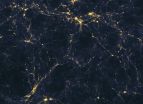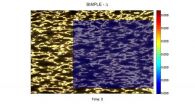(Press-News.org) New research from UCL shows we will soon uncover the origin of the ultraviolet light that bathes the cosmos, helping scientists understand how galaxies were built.
The study published today in The Astrophysical Journal Letters by UCL cosmologists Dr Andrew Pontzen and Dr Hiranya Peiris (both UCL Physics & Astronomy), together with collaborators at Princeton and Barcelona Universities, shows how forthcoming astronomical surveys will reveal what lit up the cosmos.
"Which produces more light? A country's biggest cities or its many tiny towns?" asked Dr Pontzen, lead author of the study. "Cities are brighter, but towns are far more numerous. Understanding the balance would tell you something about the organisation of the country. We're posing a similar question about the universe: does ultraviolet light come from numerous but faint galaxies, or from a smaller number of quasars?"
Quasars are the brightest objects in the Universe; their intense light is generated by gas as it falls towards a black hole. Galaxies can contain millions or billions of stars, but are still dim by comparison. Understanding whether the numerous small galaxies outshine the rare, bright quasars will provide insight into the way the universe built up today's populations of stars and planets. It will also help scientists properly calibrate their measurements of dark energy, the agent thought to be accelerating the universe's expansion and determining its far future.
The new method proposed by the team builds on a technique already used by astronomers in which quasars act as beacons to understand space. The intense light from quasars makes them easy to spot even at extreme distances, up to 95% of the way across the observable universe. The team think that studying how this light interacts with hydrogen gas on its journey to Earth will reveal the main sources of illumination in the universe, even if those sources are not themselves quasars.
Two types of hydrogen gas are found in the universe – a plain, neutral form and a second charged form which results from bombardment by UV light. These two forms can be distinguished by studying a particular wavelength of light called 'Lyman-alpha' which is only absorbed by the neutral type of hydrogen. Scientists can see where in the universe this 'Lyman-alpha' light has been absorbed to map the neutral hydrogen.
Since the quasars being studied are billions of light years away, they act as a time capsule: looking at the light shows us what the universe looked like in the distant past. The resulting map will reveal where neutral hydrogen was located billions of years ago as the universe was vigorously building its galaxies.
An even distribution of neutral hydrogen gas would suggest numerous galaxies as the source of most light, whereas a much less uniform pattern, showing a patchwork of charged and neutral hydrogen gas, would indicate that rare quasars were the primary origin of light.
Current samples of quasars aren't quite big enough for a robust analysis of the differences between the two scenarios; however, a number of surveys currently being planned should help scientists find the answer.
Chief among these is the DESI (Dark Energy Spectroscopic Instrument) survey which will include detailed measurements of about a million distant quasars. Although these measurements are designed to reveal how the expansion of the universe is accelerating due to dark energy, the new research shows that results from DESI will also determine whether the intervening gas is uniformly illuminated. In turn, the measurement of patchiness will reveal whether light in our universe is generated by 'a few cities' (quasars) or by 'many small towns' (galaxies).
Co-author Dr Hiranya Peiris, said: "It's amazing how little is known about the objects that bathed the universe in ultraviolet radiation while galaxies assembled into their present form. This technique gives us a novel handle on the intergalactic environment during this critical time in the universe's history."
Dr Pontzen, said: "It's good news all round. DESI is going to give us invaluable information about what was going on in early galaxies, objects that are so faint and distant we would never see them individually. And once that's understood in the data, the team can take account of it and still get accurate measurements of how the universe is expanding, telling us about dark energy. It illustrates how these big, ambitious projects are going to deliver astonishingly rich maps to explore. We're now working to understand what other unexpected bonuses might be pulled out from the data."
INFORMATION:
What lit up the universe?
2014-08-27
ELSE PRESS RELEASES FROM THIS DATE:
Sheepdogs use simple rules to herd sheep
2014-08-27
Sheepdogs use just two simple rules to round up large herds of sheep, scientists have discovered.
The findings could lead to the development of robots that can gather and herd livestock, crowd control techniques, or new methods to clean up the environment.
For the first time scientists used GPS technology to understand how sheepdogs do their jobs so well. Until now, they had no idea how the dogs manage to get so many unwilling sheep to move in the same direction.
NERC fellow, Dr Andrew King of Swansea University, fitted a flock of sheep and a sheepdog with backpacks ...
Everest expedition provides first evidence of effects of altitude on blood pressure
2014-08-27
An expedition to Mount Everest by Italian researchers has shown for the first time that blood pressure monitored over a 24-hour period rises progressively as people climb to higher altitudes. The researchers also found that while a drug used for lowering blood pressure, called telmisartan, was effective in counteracting the effects of altitude up to 3400 metres, it was not effective at 5400 metres above sea level – the height of the Everest base camp.
The study is published online today (Wednesday) in the European Heart Journal [1], and its findings have implications ...
Animals first flex their muscles
2014-08-27
An unusual new fossil discovery of one of the earliest animals on earth may also provide the oldest evidence of muscle tissue – the bundles of cells that make movement in animals possible.
The fossil, dating from 560 million years ago, was discovered in Newfoundland, Canada. On the basis of its four-fold symmetry, morphological characteristics, and what appear to be some of the earliest impressions of muscular tissue, researchers from the University of Cambridge, in collaboration with the University of Oxford and the Memorial University of Newfoundland, have interpreted ...
Sleep apnea treatment is effective for older people
2014-08-27
Continuous positive airway pressure is effective at treating sleep apnoea in older people, a new study has found.
Obstructive sleep apnoea (OSA) is a condition where the walls of the throat relax and narrow during sleep, interrupting normal breathing and causing profound sleepiness. For people with moderate or severe OSA, doctors usually recommend using a continuous positive airway pressure (CPAP) device, which consists of a small pump that delivers pressurised air into the nose through a mask, stopping the throat from closing.
Previous studies have established the ...
New scientific review investigates potential influences on recent UK winter floods
2014-08-27
A comprehensive review of all potential factors behind the 2013/2014 UK winter floods is published today in the journal Nature Climate Change. The paper does not definitively answer whether human activity played a role in the magnitude of the winter flood events. It does, though, examine how factors such as the state of the global oceans may have interacted with wind patterns and subsequent high-level atmospheric features.
The review was led by scientists at the Centre for Ecology & Hydrology, in collaboration with the Met Office and the Universities of Oxford, Exeter ...
Social inequalities in salt consumption remain
2014-08-27
People from low socio-economic positions in Britain still eat more salt than those from higher socio-economic positions, irrespective of where they live.
A paper published in the BMJ Open journal and led by Warwick Medical School suggests social inequalities in salt intake have hardly changed in the period from 2000-01 to 2011. This is despite a national average salt reduction over this time.
This paper is the first to monitor social inequalities following the national salt reduction programme.
The research was carried out by the World Health Organization Collaborating ...
New technology may identify tiny strains in body tissues before injuries occur
2014-08-27
VIDEO:
As a piece of plastic wrap is stretched, the new algorithms identify the location (in red) where it is weakening, which is where the material eventually breaks.
Click here for more information.
Researchers at Washington University in St. Louis have developed algorithms to identify weak spots in tendons, muscles and bones prone to tearing or breaking. The technology, which needs to be refined before it is used in patients, one day may help pinpoint minor strains and tiny ...
New estrogen-based compound suppresses binge-like eating behavior in female mice
2014-08-27
HOUSTON – (Aug. 26, 2014) – Binge eating, an eating disorder in which a person frequently consumes unusually large amounts of food in a short period of time, affects about 5 to 10 percent of U.S. adults and is more common in women than men. Researchers at the USDA/ARS Children's Nutrition Research Center at Baylor College of Medicine and Texas Children's Hospital found that the hormone estrogen can specifically trigger brain serotonin neurons to inhibit binge eating in female mice in a report today in the Journal of Clinical Investigation.
"Previous data has shown that ...
Researchers discover fever's origin
2014-08-27
Fever is a response to inflammation, and is triggered by an onset of the signaling substance prostaglandin. Researchers at Linköping University in Sweden can now see precisely where these substances are produced – a discovery that paves the way for smarter drugs.
When you take an aspirin, all production of prostaglandins in the body is suppressed. All symptoms of inflammation are eased simultaneously, including fever, pain and loss of appetite. But it might not always be desirable to get rid of all symptoms – there is a reason why they appear.
"Perhaps you want to inhibit ...
Tumor blood vessel protein provides potential therapeutic target
2014-08-27
Tumor blood vessels supply oxygen and nutrients to cancer cells and provide access to other organs. While tumor vasculature shares many features with normal vessels, their unique characteristics are potential therapeutic targets. A recent study in the Journal of Clinical Investigation identifies a tumor vessel-specific protein, L1 that can be targeted to reduce tumor growth. Using a mouse pancreatic cancer model, Ugo Cavallaro and colleagues at the European Institute of Oncology found that loss of L1 reduced tumor blood vessel formation, which inhibited growth and metastasis. ...



